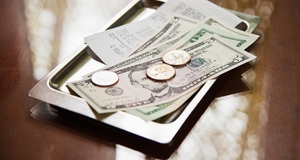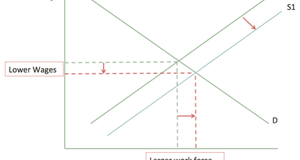Foodservice Experience and Tipping Behavior: Further Evidence of Wage-Inequality Between Tipped and Non-Tipped Workers
By
2015, Vol. 7 No. 12 | pg. 1/1
IN THIS ARTICLE
KEYWORDS
AbstractThis study focuses on the relationship between prior foodservice experience and a person’s tipping behavior. Using data from a survey of 500 University of Maryland undergraduate students, an analysis is completed by regressing restaurant experience and waiting experience on perceived average tip percentage while controlling for gender and ethnicity. A positive, significant relationship is found between the two independent variables regarding work experience and the dependent variable. This research is an attempt to illustrate the wage-inequality between tipped workers and non-tipped workers, as the tipped minimum wage is often times less than the federal minimum wage in the U.S. Fluctuations in the wages of servers can be explained by the inconsistency of the wage subsidy provided by the customer in the form of a tip. These inconsistencies arise from factors outside of the server’s control that influence a customer’s tipping behavior. The Development of Tipping BehaviorWithin the United States, the act of tipping at a restaurant has become a customary practice. A tip is any addition to a restaurant bill; however, it was once given to a server in exchange for good service. The purpose of the tip was changed due to the temperance movement in the U.S. With the ratification of the 18th Amendment restaurants lost profit due to the lack of alcohol sales. Tipping became predominant within the U.S. when restaurants could no longer afford to pay their workers a full wage. Gratuity was encouraged as a way of subsidizing the wages of restaurant workers affected by this decrease in pay. Tipping as a wage subsidy to servers became a permanent part of the restaurant industry with the passing of The Fair Labor Standards Acts (FLSA) of 1938. Regulations were made for employers of tipped workers requiring them to make up the difference between the employee’s wage and the minimum wage. In 1966 the introduction of the subminimum wage cemented the tip as wage subsidy to workers who regularly receive tips in the U.S. labor market. From that moment on customers have paid tipped employees the remainder of their wage not accounted for by the subminimum wage.The federal subminimum wage or the “tipped minimum wage” currently stands at $2.13 per hour, a full $5.12 less than the federal minimum wage of $7.25. Amendments to the FLSA have created three tipping systems within the U.S. Twenty-six states require employers to pay workers above the federal tipped minimum wage, a number which ranges from $2.23-$7.46. However, only seven U.S. states have adopted a policy in which they are required to tip at least the state minimum wage, all of which are greater than or equal to 7.25. The disparity between the federal minimum wage and the tipped minimum wage in the larger part of the U.S. is consistent with the findings of Azar and Tobol (2008) in which they discovered that tips make up more than half of a server’s income. Therefore it is crucial to examine the tipping behavior of customers. Many studies have been conducted examining a variety of factors that determine tipping behavior. The factors examined by Conlin, Lynn and O’Donoghue (2003) included the age of tipper, the gender of the tipper in relation to the gender of the server, the time of the meal, as well as repeated interaction. Age had a positive effect on tipping percentage. Teenagers and young adults tipped less on average than adults. The effect of an increase in number of patrons was negative in relation to tip; as the restaurant became busier the quality of service decreased and so did tip. Repeated interaction increased tipping percentage on two fronts: first, as the server and the customer build a relationship the tip increases. Second, quality of service increases with repeated interaction, which has a positive affect on tipping percentage. Cross-gender interactions also increased tipping percentage. Females were willing to tip higher amounts if their server was male and males were more likely to tip well if their server was female. A study conducted by Lynn and Thomas-Haysbert (2003) focused on the difference in tipping practices among ethnicities. The findings supported their theory that African Americans tip less on average than White customers. These findings are very interesting because while the tip differed greatly between ethnicities, the perception of service did not. According to these findings the tip could not be controlled by the server because African Americans have a predetermined tipping percentage that they thought was appropriate that was less than the white cultural norm of a 15-20% tip. This study also determined that Hispanics tipped less than Whites on average. Lynn, M. & Williams, J. (2012) found that this difference could be explained by the socio-economic (SEC) status of the person. If a person’s socio-economic level increased, so would their tip. However even after the SEC of a black customer increased, their average tip still remained lower than a white person in the same SEC level. Parrett (2003) found that the size of the party being served affected the tip size. Parrett determined that with parties of less than 3, the tip decreases with size, and for parties of more than 3 the tip increases with size. Boyes, Stewart Mounts Jr., and Clifford Sowell (2006) found that women were less likely to be swayed by the tipping norm, and therefore less likely to increase their tip. Furthermore, on average women tipped less than men. Lynn and Latane (1984) determined that the payment type of the customer also influenced their tipping behavior. Customers who used credit cards tipped more than cash users. A common theme emerges among this previous research. All of the factors examined are out of the control of the server. A server does not have the power to influence table size, payment type, number of patrons, and the gender, age, and SEC of their customers. This research has established a clear differential between these factors and the wage in which a server receives. In the larger part of the U.S., servers are paid a tipped-minimum wage lower than the federal minimum wage per hour. The remainder of their wage is provided in the form of a subsidy via a customer’s tip. If tipping among customers is inconsistent due to factors outside of the control of the server, then this subsidy is an unreliable source of income. This study aims to provide further evidence of the inconsistency of the tip as a wage subsidy and illustrate the wage-inequality that exists in the labor market between workers who receive a tip and workers that do not. More specifically, it will explore the gap in average tip between persons who have foodservice experience and those who do not. MethodologyThe data used in this study was obtained from a survey conducted at the University of Maryland (Fisher, 2014). The in-person survey contained 500 observations of University of Maryland undergraduate students. Of the 500 participants, when asked what ethnicity they identified with, 316 said White, 95 Asian, 53 said Black or African American, and 36 students considered themselves to be some other race. 316 of the participants were female and 184 were male (for more details see, Fisher, 2014). Dependent VariableParticipants of the survey were asked: “In the United States, what tipping percentage do you consider to be average?” Participants were given predetermined tipping percentages in 5% increments (i.e. 5 – 25 percent) to choose from. Additionally, the participants were asked to rate 5 statements regarding their personal tipping and restaurant-going beliefs. The results of these ratings were not used in this study because the interest was in the effect of the independent variables on the participant’s perception of the average tip and not in their perception of the necessity of tipping. Independent VariableIn addition to the average tipping percentage question, participants were also asked whether they had experience working in a restaurant and if they had experience working as a waiter/ waitress. Answering yes to the restaurant experience question but no to the waiting experience question indicated that the participant had worked in a restaurant but not as a server. Those that answered yes to the waiting question also answered yes when asked if they had previous restaurant work-experience. The surveys of participants who had worked as a waiter but answered no to the question regarding restaurant experience were discarded. For each question, “yes” was encoded with the value of 1, and “no” was encoded with the value of 0. Participants were asked to indicate the gender and ethnicity group to which they identified with. Participants were also asked to indicate whether or not they were undergraduate students. Surveys in which the participant answered no to the undergraduate question were discarded in an attempt to have a homogenous sample within the same socio-economic level. Dummy variables were created for the independent variables regarding gender and ethnicity. Those that identified with female were given the binomial value of 1, and those that identified with male were given the value of 0. Three dummy variables were created to represent ethnicity. The first assigned the value of 1 to any participant that identified as White and the value of 0 to those that identified other wise. The same system was used to create dummy variables for those that identified as Asian and Black or African American. ResultsThe dependent variable was analyzed using a hierarchal ordinary least squares (OLS) regression with heteroskedasticity robust standard error (SE). The first study regressed only restaurant experience on average tip percentage. The second study regressed only waiting experience on average tip percentage. The following studies analyzed the dependent variable using the two-way interaction of the independent variables “rest” (restaurant experience) and “wait” (waiting experience). Study 4 controlled for gender and Study 5 controlled for gender and ethnicity. See appendix for OLS linear regression models for each study. Consistent with the analyses of this data reported by Fisher (2014), restaurant experience had a positive effect on perceived average tip (β1= .0357, SE(rest)= .0027, P<.001) when analyzed alone. When isolated waiting experience also had a positive effect on average tip percentage (β1= .046, SE(wait)= .0032, P<.001). When a multiple linear regression was run on the two-way interaction of waiting and restaurant experience both effects remained positive. However, the coefficient of waiting experience diminished slightly, but the coefficient of restaurant experience decreased significantly (β1= .0155, β2= .0348, SE(rest)= .0028, SE(wait)=.0038), p<.001). All variables in studies 1, 2, and 3 were significant using a p-value less than .001. Study 4 controls for gender. We see a similar effect of waiting experience and restaurant experience on average tip, however with a very slight increase in β-values and SE. In contrast to waiting and restaurant experience being female has a negative effect on average tipping percentage (β3= -.0078, SE(.0025)= .0032, P<.01). Study 5 controls for gender and ethnicity. All independent variables involving ethnicity had a positive effect on average tip percentage, however only White and Asian held any significance, albeit only at a p-value of less than .1 but greater than .05. While controlling for gender and ethnicity, the effect of restaurant experience decreased and waiting experience increased, both very slightly. All constants remained in the 15-16% range, while remaining statistically significant at a p-value of less than .001 (see table 1 for details). DiscussionA reanalysis of the survey data collected by Fisher (2014) found that in all stages of the hierarchical analysis, restaurant and waiting experience had a positive, significant effect on the perceived average tipping percentage of participants. The analysis also found that the effect on tipping percentage was larger for participants with waiting experience. The decrease in the coefficient of restaurant experience while controlling for waiting experience is consistent with the findings of Fisher (2014) and the theories of Lynn (2009). This previous research suggests that a factor behind increased tipping percentage is the ability of the customer to empathize with their server. People with prior foodservice experience have either observed or experienced first-hand the effects of a poor tip on hourly wage, thus they are more likely to empathize with a server and tip a higher percentage. Non-servers in restaurants either work for an hourly wage and no tips or get tipped a percentage of total sales but never deal directly with a customer for tips. Therefore participants with waiting experience would likely feel it more important to tip a server a higher percentage than someone with restaurant experience but no actual serving experience. The inclusion of gender in the regression model of Study 4 supports Boyes, Stewart Mounts Jr., and Clifford Sowell (2006) findings that women tip less on average than men. However, the slight increase in coefficient size for both waiting and restaurant experience suggests that prior foodservice experience has a significant impact on both men and women. Controlling for ethnicity and gender in addition to waiting and restaurant experience suggests that ethnicity of a participant is not as significant when determining tipping behavior as the other controlled factors. All ethnicity variables (i.e. White, Asian, and Black) had a positive effect on tipping percentage, however, White and Asian were the only variable that held any statistical significance, however, it was a very weak significance. This lack of significance could be explained by a variety of factors. Most likely, the complete lack of significance of the variable “black” could be explained by the small sample size of Black or African Americans who were surveyed. The weak significance of being Asian is consistent with the findings of Lynn and Thomas-Hayber (2003) who studied the effect of being Asian and Hispanic on tipping behavior and found only a correlation between being Hispanic and a decrease in average tipping percentage. Additionally, Study 5 found that while controlling for gender and ethnicity the coefficients of waiting and restaurant experience remained relatively unchanged, however there was a slight increase of the coefficient of waiting experience from the coefficient in Studies 2 and 3, but a slight decrease of the coefficient of restaurant experience. The difference in coefficient size should be explored further in future research as there is currently no evidence explaining why waiting experience may sway a person’s tipping behavior more than restaurant experience, when controlling for ethnicity. Additionally, the relative consistency of the constant in each study (ranging from 15-16%) agrees with Lynn and Thomas-Haysbert’s (2003) findings that the white cultural norm for tipping is within the 15-20% range. This is especially relevant when considering the large sample size of white participants, relative to other ethnicities, in the sample population. This research represents an attempt to call into question the validity of the U.S. tipping system. If there are so many factors, that a server cannot control, that influence the tipping behavior of customers, then there must be inconsistency in the wages of servers. For the most part, a server cannot choose his or her customers and therefore may serve someone with lower tipping average. Not every customer is the optimum combination of white and male with a high SEC status who has worked as a waiter previously. Every customer is different, every tip is different, and therefore the wage of a server will fluctuate. Why then, do servers still get paid under the federal minimum wage? Further research should be conducted using a larger sample to see if restaurant and waiting experience have an affect on average tip on a grander scale. The analysis of the data obtained from the larger sample of U.S. adults should also control for SEC status and age to determine if these have a moderating effect on restaurant and waiting experience. ReferencesAzar, O.H., Tobol, Y. (2008). Tipping as a Strategic Investment in Service Quality: An Optimal-Control Analysis of Repeated Interactions in the Service Industry. Southern Economic Journal 75, 246-260 Boyes, W. J., Stewart Mounts, W. and Sowell, C. (2004), Restaurant Tipping: Free-Riding, Social Acceptance, and Gender Differences. Journal of Applied Social Psychology, 34:2616–2625. doi:10.1111/j.1559-1816.2004.tb01995.x Conlin, M., Lynn, M., & O’Donoghue, T. (2003). The norm of restaurant tipping. Journal of Economic Behavior & Organization, 52(3), 297-321. doi: 10/1016/S-167-2681(03)00030-1 Fisher, K. (2014). How Much Should I Tip? Restaurant Tipping Behavior as a Result of Prior Foodservice Experience. Student Pulse, Vol. 6 No. 10 (October). Lynn, M. (2009). Individual difference in self-attributed motives for tipping: Antecedents, consequences, and implications. International Journal of Hospitality Management, 28(3), 432-432. doi: 10.1016/j/ijhm.2008.10.009 Lynn, M., & Latané, B. (1984).The psychology of restaurant tipping[Electronic version]. Retrieved January 5, 2015, from Cornell University, SHA School site: http://scholarship.sha.cornell.edu/articles/45 Lynn, M. & Williams, J. (2012). Black-white difference in beliefs about the U.S. restaurant tipping norm: Moderated by socio-economic status? International Journal of Hospitality Management, 31(3), 1033-1035. doi: 10.1016/j.ijhm.01.004 Lynn, M. & Thomas-Haysbert, C. (2003). Ethnic Differences in Tipping: Evidence, Explanations, and Implications. Journal of Applied Social Psychology, 33(8), 1747-1772. doi: 10.1111/j.1559-1816.2003.tb01973.x Parrett, M. (2003). The Give and Take on Restaurant Tipping. Retrieved January 1, 2015, from http://scholar.lib.vt.edu/theses/available/etd-10172003-021146/unrestricted/ETDDissertation.pdf AppendixTable 1: Regression Models
*p<.1 **p<.05 ***p<.001 Regression Models
Suggested Reading from Inquiries Journal
Inquiries Journal provides undergraduate and graduate students around the world a platform for the wide dissemination of academic work over a range of core disciplines. Representing the work of students from hundreds of institutions around the globe, Inquiries Journal's large database of academic articles is completely free. Learn more | Blog | Submit Latest in Economics |


















